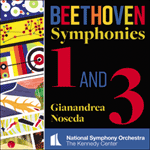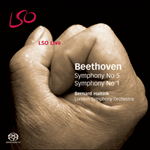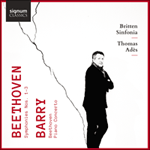
Welcome to Hyperion Records, a British classical label devoted to presenting high-quality recordings of music of all styles and from all periods from the twelfth century to the twenty-first.
Hyperion offers both CDs, and downloads in a number of formats. The site is also available in several languages.
Please use the dropdown buttons to set your preferred options, or use the checkbox to accept the defaults.

The slow movement’s opening pages have staggered thematic entries in the manner of a fugato; and when the cellos add a new ‘running’ part to the texture at the start of the reprise, the music manages miraculously to sound even more translucent. Another felicitous piece of scoring is the ‘tapping’ timpani rhythm that runs through the exposition’s closing bars. In a characteristically Beethovenian gesture, the rhythm is appropriated by the strings, fortissimo and in a distant key, at the start of the central development section.
For all the defiant originality of its slow introduction, perhaps the symphony’s most prescient movement is the third—not really a minuet at all, despite its label, but a piece in Beethoven’s dynamic, thrusting scherzo style. As for the finale, it opens with a celebrated joke. A dramatic held note played fortissimo by the full orchestra seems to herald some event of high seriousness, but all that ensues are scraps of a C major scale, hesitantly put together in slow-motion by the violins. The scale is fully assembled only at the start of the Allegro molto e vivace, where it turns out to form the upbeat to the main theme. The music’s wit and brilliance again owe something to Haydn, though there is no shortage of thoroughly Beethovenian gestures—not least, the dramatic outburst near the start of the central development section. Towards the end, Beethoven cheekily introduces a march of toy soldiers, before bringing the work to a rousing conclusion.
from notes by Misha Donat © 2007
Les pages d’ouverture du mouvement lent ont étalé les entrées thématiques à la manière d’un fugato; et lorsqu’en début de reprise, les violoncelles ajoutent à la texture une partie «allante», la musique parvient miraculeusement à sonner avec une translucidité accrue. Autre moment d’écriture heureux: le rythme «tapotant» des timbales qui court sur les mesures conclusives de l’exposition. Dans un geste tout beethovénien, le rythme est accaparé par les cordes, fortissimo et dans une tonalité éloignée, au début de la section de développement centrale.
Malgré toute l’originalité provocatrice de l’introduction lente, le mouvement le plus prescient de la symphonie est peut-être le troisième—qui n’est en rien un vrai menuet, quoi qu’en dise son titre, mais un morceau dans le style de scherzo beethovénien, dynamique et entreprenant. Quant au finale, il s’ouvre sur une facétie célèbre. Une dramatique note tenue jouée fortissimo par le grand orchestre semble présager un événement des plus sérieux, mais tout ce qui vient, ce sont des bribes d’une gamme en ut majeur timidement réunies par les violons, au ralenti. Cette gamme n’est entièrement assemblée qu’au début de l’Allegro molto e vivace, où elle devient l’anacrouse du thème principal. Là encore, l’esprit et le brio de la musique doivent beaucoup à Haydn, même si les gestes profondément beethovéniens ne manquent pas—à commencer par la spectaculaire explosion non loin du début de la section de développement centrale. Vers la fin, Beethoven introduit effrontément une marche de soldats de plomb avant d’amener l’œuvre à une conclusion vibrante.
extrait des notes rédigées par Misha Donat © 2007
Français: Hypérion
Die ersten Seiten des langsamen Satzes weisen versetzte Themenseinsätze in der Art eines Fugatos auf. Wenn die Violoncelli zu Beginn der Reprise eine „laufende“ Stimme zur Textur hinzufügen, gelingt es der Musik wie durch ein Wunder, noch durchsichtiger zu klingen. Eine weitere geglückte Kompositionsidee ist der „klopfende“ Paukenrhythmus, der sich durch die abschließenden Expositionstakte zieht. In einer für Beethoven typischen Geste wird der Rhythmus von den Streichern zu Beginn des zentralen Durchführungsabschnittes fortissimo und in einer entfernten Tonart übernommen.
Die langsame Einleitung mag durch ihre eigenwillige Originalität hervorstechen. Am weitesten voraus schaut aber vielleicht der dritte Satz. Trotz der Überschrift ist er nämlich überhaupt kein richtiges Menuett, sondern ein Stück in Beethovens dynamischer, vorwärts drängender Scherzofasson. Der Schlusssatz beginnt mit einem berühmten musikalischen Scherz. Eine ausgehaltene dramatische und vom gesamten Orchester fortissimo gespielte Note scheint ein Ereignis von großer Ernsthaftigkeit anzukündigen. Darauf folgen aber nur Fetzen einer C-Dur-Tonleiter, die von den Violinen in Zeitlupe und nur zögernd zusammengesetzt werden. Die Tonleiter als Ganzes erklingt erst am Anfang des Allegro molto e vivace, wo sie sich als Auftakt zum Hauptthema herausstellt. Der Witz und die Brillanz der Musik sind wieder Haydn etwas schuldig, es gibt allerdings auch keinen Mangel an typisch Beethoven’schen Gesten—nicht zuletzt im dramatischen Ausbruch kurz vor Beginn des zentralen Durchführungsabschnitts. Gegen Ende führt Beethoven unverfroren einen Marsch für Spielzeugsoldaten ein, bevor er das Werk zu einem mitreißenden Abschluss bringt.
aus dem Begleittext von Misha Donat © 2007
Deutsch: Elke Hockings
 Beethoven: Symphonies Nos 1 & 3 Beethoven: Symphonies Nos 1 & 3Fine performances of two of Beethoven's pioneering early symphonies—No 1 from 1800, and the epic 'Eroica' completed just a few years later.» More |
 Beethoven: Symphonies Nos 1 & 5 Beethoven: Symphonies Nos 1 & 5Beethoven again raised the expressive force of the genre with his Symphony No 5 and introduced a theatrical element to it. Beginning with the most famous phrase in classical music and one of the most joyous, uplifting movements as a finale it is a ...» More |
 Beethoven: Symphonies Nos 1, 2 & 3 Beethoven: Symphonies Nos 1, 2 & 3These much-anticipated recordings were made during the Britten Sinfonia's three-year Beethoven symphony project. Conductor Thomas Adès interleaves Beethoven’s masterworks with the audacious and sometimes explosive music of the wonderfully idiosync ...» More |

